When was the last time you went 24 hours without internet access? If you’re anything like me, it’s been… a while.
My recent stay at the bucolic Mt Barney Lodge was ostensibly to take part in a First Nations-led immersive learning experience, but as that dreaded SOS symbol replaced my healthy 5G signal, I realised I had also signed up for a mini-digital detox. What I didn’t know then was just how much I had NEEDED that time away, and how much I would learn without the push and pull distraction of my phone.
Also the versatile brilliance of the lemon myrtle tree, but we’ll get to that.
Walking together
Nestled near the base of the great peak itself, the Mt Barney Lodge is the home of a quiet revolution in both local tourism and blackfella/whitefella partnerships. The lodge is operated by Innes and Tracy Larkin, and they’ve teamed up with Ugarapul man Kruze Summers to create the Yarriba experience—the first of its kind in the Scenic Rim.
Yarriba means “walking together”, and that’s exactly what you’ll do on this overnight dive into both the cultural heritage of the region, and the science of the nature that surrounds you. If you’re like me (ie, not First Nations) you probably know some basics about the connection Aboriginal and Torres Strait Islander peoples have with Country. You’ll know that the many hundreds of mobs that populated our continent for at least 60,000 years managed the land efficiently and lived with a deep respect for nature.
If you’re like me, you might also feel like you’d like to know more, but feel a bit lost and awkward about how to do that in a real, physical way. And that’s where the 5G signal goes off, and Kruze and Innes come in. Using the beautiful grounds of the Mt Barney Lodge, the pair educate, entertain and enlighten.
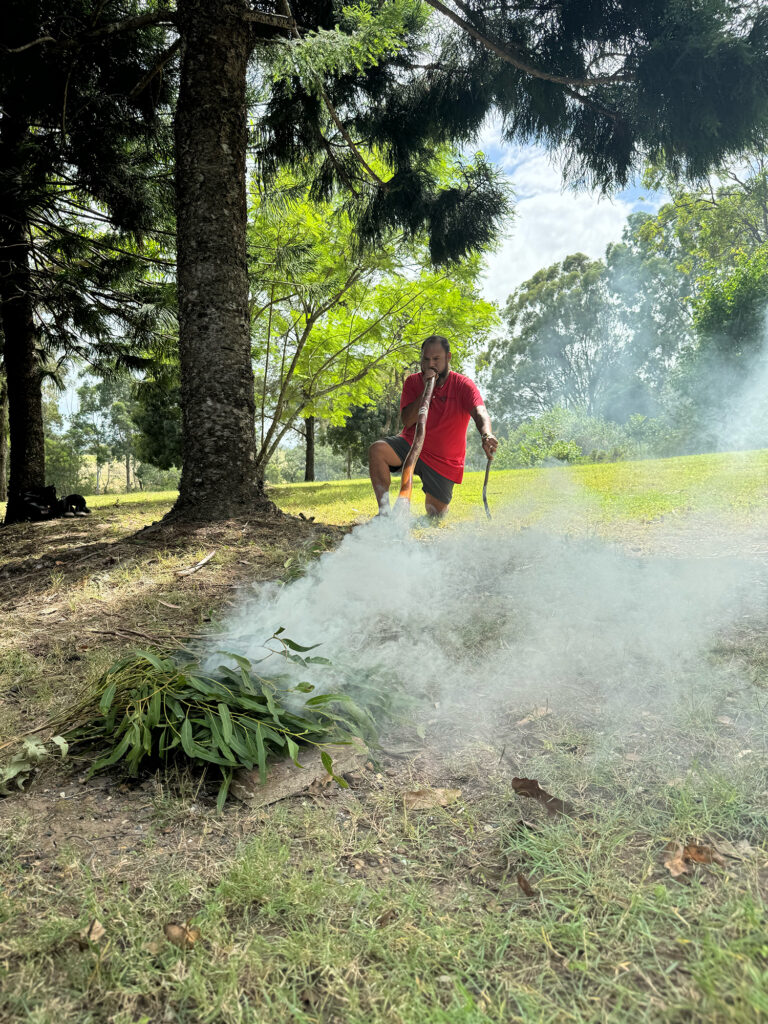
The morning begins with a smoking ceremony, with Kruze placing lemon myrtle on top of the customary eucalyptus leaves to add more fragrance to the cleansing smoke. There’s a burst of didgeridoo, a welcome in traditional language, and an informal explanation from Kruze about how he inherited both his traditional name Gurruhmun “Old Man Kangaroo” and his stories from his late grandfather, Uncle John, and now wants to continue that legacy.
Then it’s off to explore the grounds of Mt Barney Lodge, stopping at a bower bird’s nest to show the impact plastics can have on the bird population (the male that collects the most blue plastic essentially pushes the other males out, reducing the gene pool); and showing us the difference between native grasses and imported ones on the usability of the land.

We visit a sacred waterhole, a place where both local catfish and women would go to give birth. Water birth, Kruze tells us, was important to create an immediate connection to Country. The profile of Mt Barney itself is supposed to be a pregnant woman lying down and in labor, so the site the link from Country, to people, back to Country was maintained.
Kruze says he likes to tell kids to imagine the site as a busy suburban community, with the waterhole being the gathering ground, medicine trees lining the banks acting as a chemist with soap trees for antibacterial properties and lemon myrtle for respiratory relief, and the high ridges bordering the site being a source of food as well-stocked as their local supermarket. Strictly speaking, Kruze shouldn’t be allowed in this space, as traditionally male and female “business” was kept firmly separate. But he has dispensation in order to share its historic purpose with others.
Innes, who’d swum in the waterhole for years as the property owner, stopped once he found out. “I have plenty of other waterholes I can use,” he says.
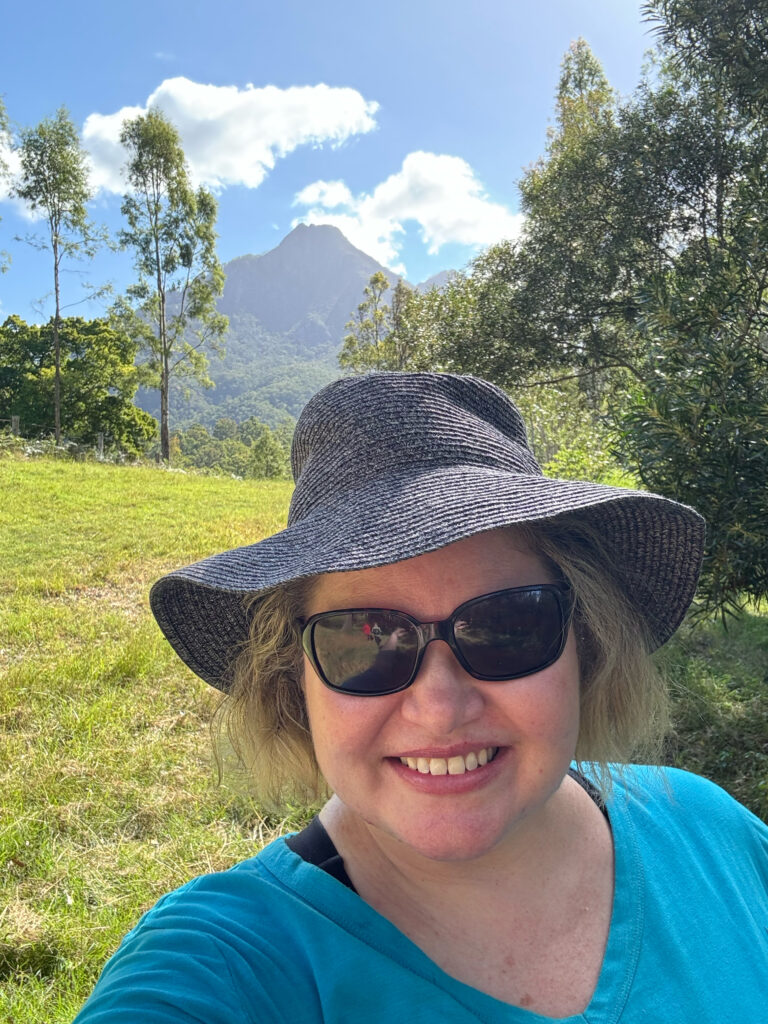
Lunch and learning
Homemade turkey salad rolls and old-fashioned lemonade and ginger beer make for a perfect bush lunch, along with the simple and delightful treat of a lemon myrtle tea. A few fresh leaves steeped in boiling water turns out to be a refreshing yet comforting drink.
Kruze shows us some stunning stone tools, including handheld stone axes that were used not simply to “chop” wood from trees, but almost to “coax” the trees into parting with it. “We weren’t stupid, we could have created stronger axes to chop down trees,” Kruze says. “But we didn’t want to kill the trees; we wanted to ensure they lived on, and took only what we needed.”
Other tools were used for grinding seeds, flaying the skin from animals, and digging. He keeps the tools that would have belonged to women wrapped in tea towels, as it would be inappropriate of him to touch them with bare hands. This etiquette is practiced through the experience, highlighting the way traditional men’s and women’s work was respected from a distance.
After lunch, we freshen up at the main homestead, Moringararah, originally built in the late 1900s. It’s a charming Queenslander with beautiful wooden floors and simple amenities. The property also boasts a number of small huts, plus two permanent glamping tents, set up to ensure the 1359m Mt Barney itself fills the view.
A mountain to climb
Campers and caravaners are also welcome at Mt Barney Lodge, with numbers capped at 100 to ensure the peace and quiet is maintained. Innes and Tracy offer a number of other outdoor adventures for both families and adrenaline junkies – the bolder visitor can choose a day-long hike up to the top of Mt Barney. Although as Kruze hilariously tells us, “Climbing mountains is such a white man thing. We know the best view of the mountain is from the ground, looking up at it.”
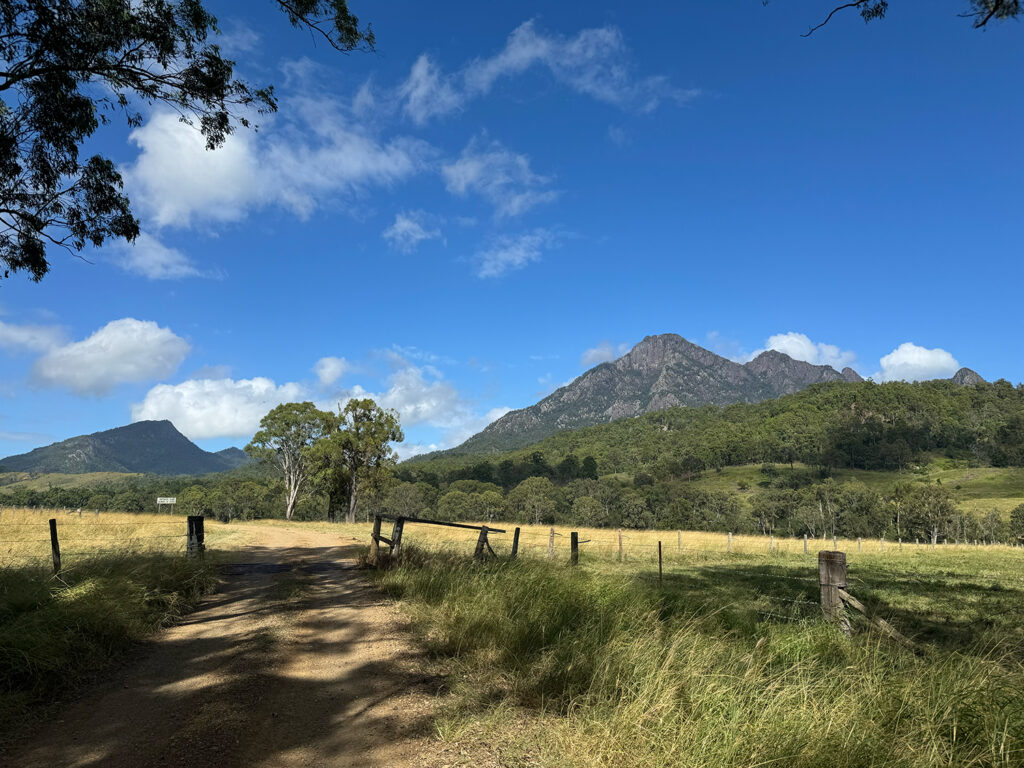
Innes adds that this philosophy has a practical reason too, because mountain climbing is hard, and requires abundant calories to complete. Practically, it made no sense for local mobs to expend precious energy that way—although Kruze says spiritual men would climb the nearby Mt Lindsey for cultural reasons on occasion.
Fun fact—the first white man to actually climb Mt Barney was Patrick Logan, the much-despised commandant of the Moreton Bay Penal Settlement. He scaled the peak in 1828.
Another fun fact—Captain Logan’s death two years later was blamed at the time on Aboriginal people, after his body was found in a shallow grave near Mount Beppo. But Kruze and Innes have reason for scepticism, given Logan’s enforcement of hard labour and brutal punishment: “Everybody hated that guy!”
Our afternoon loop begins in the lodge’s herb garden, with Warrigal greens (a great alternative to rocket that, in a good bit of trivia, was the first native food Captain Cook ate) and native ginger sprouting healthily. There’s more starchy bush tucker to be found in the long stalks of the bulrush reed, and more intoxicating fragrance from the lemon-scented gum. Dozens of amorous monarch butterflies accompany our walk as the afternoon sun warms our way.
Kruze is a member of Firesticks, an Indigenous-led organisation working to revitalise traditional cultural burning to help better land management. He gives us a small demonstration of “cool burning”, a way of clearing away dead plant matter with minimal impact. Seizing a clump of lomandra grass at the root, he shows us both the green and brown roots, mixed at near half/half proportions. His ancestors would have known this as a sign to carry out maintenance burning.“Country always tells you what it needs,” he says.
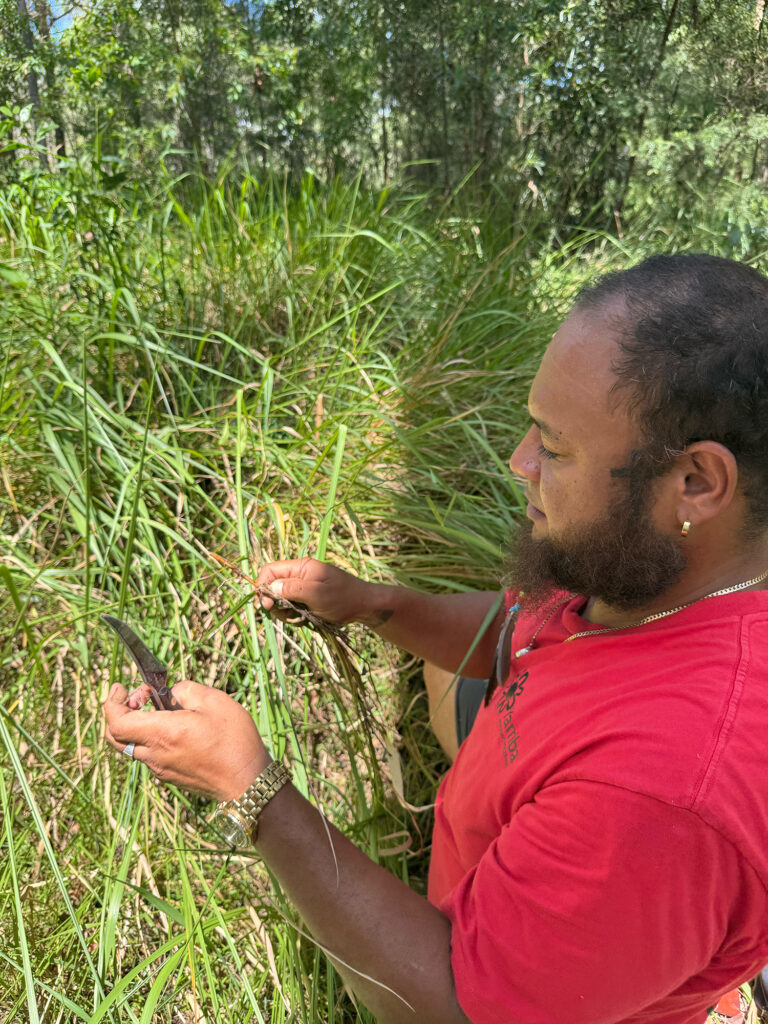
A flicker of spark and the base of the plant is alight with low orange flame. “See that?” Kruze says, passing his hand through the blades. “It’s not hot.” Such small spot fires could be happily left to burn away rotting green matter before handily burning themselves out. Placing a hand on the extinguished burn site confirms that it only feels warm like a wheat bag, not scalding like a doused camp fire. Kruze says the small fires would also act as warning signs for local fauna, encouraging them to leave the area. Indeed, he points at several small spiders yoinking their way back up their webs into the trees as evidence.
We wind up at Innes and Tracy’s outdoor fire pit, looking out over a magnificent stretch of rocky outcrops. There are caves up there with rock paintings dating back thousands of years, but Innes—an avid mountain climber who’s rescued more than 400 people lost on Mt Barney—doesn’t want to find them. “If people know about them, they’ll try to find them, and that could end up ruining them,” he says.
Kruze takes some time to show us his collection of weapons, most of them inherited from his grandfather, Uncle John. There are woomeras and a bullroarer, wooden clubs used to crack the heads of kangaroos and emus, and of course, boomerangs, both of the returning and non-returning varieties.
One of the best parts of Yarriba is that fact that while, yes, there is a schedule… it’s not strict. Kruze welcomes questions, and will answer as many as he can. He’s cheeky and loves a laugh. Innes—an avid student of botany—will pipe in with scientific names and classifications. The pair rib each other playfully. It’s a wonderful yin/yang partnership, that allows for a detailed and personalised experience.
Simple and hearty food for the soul
Once the day’s activities officially conclude, we’re ready for a cool, cosy evening by the fire pit. Tracey has spent the late afternoon getting the fire pit nice and hot, and has two big cast iron ovens on the steaming charcoals. We nibble on a cheese platter and sip wine, before Tracy reveals her triumphant feast: a slow-cooked Y-bone steak and vegetable stew and freshly made damper. “Bread, salt, water—no bells and whistles,” Tracy says.
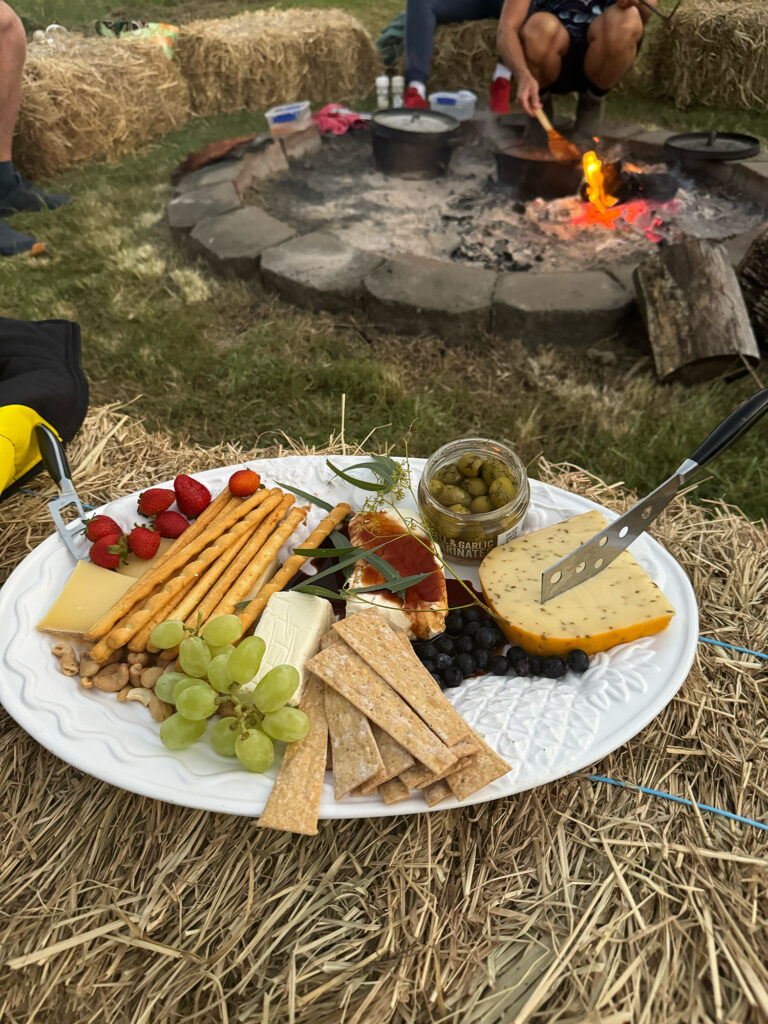
To say it’s delicious is an understatement. It’s simple food, but so hearty and filling to be almost joyous. Kruze tucks in happily too, before treating us to more didgeridoo. As the night deepens, the Milky Way emerges overheard, known to Indigenous Australians as the Emu. It’s a sight you just cannot see in the city, and a warm and beautiful way to end a day with new friends.
After good food, good wine and great conversation, we make our way back down the hill to the Moringararah homestead and bed. After a full day of learning, with no wifi or 5G to distract me, I feel pleasantly ready for sleep, with only the whirr of a ceiling fan accompanying my slumber.
We should all think more about engaging with First Nations tourism experiences around Queensland. Yarriba is perfect option for those looking to get off the grid for even a short amount of time. And, if you’re like me, you might even take a few lemon myrtle leaves with you to breathe in on the drive home.
Things To Note Before You Go:
- You need a moderate level of mobility for the walk as there are some inclines and rough tracks, but if you can manage a hike up somewhere like JC Slaughter Falls at Mt Coot-tha, you’re more than capable.
- A sturdy pair of enclosed shoes or boots will do you good, plus the usual recommendations of water, sunscreen, a hat and insect repellent.
- Mt Barney Lodge is an eco-certified property, and they do everything as sustainably as possible. Bring your own toiletries for the showers; and if you fancy a swim, there’s a gorgeous creek instead of a pool.
- There is no Wifi. You may get a weak signal from some telcos; others will leave you on SOS. My advice is: take advantage and enjoy it!
Yarriba Dreaming, Mt Barney Lodge, 1093 Upper Logan Road, Mt Barney. For all enquiries please call +61 7 5544 3233
or email [email protected].

